The Southern and Eastern Scalefish and Shark Fishery (SESSF) is a multi-sector, multi-species fishery that covers almost half of the Australian Fishing Zone.
AFMA manages this fishery by limiting the catch, restricting how many boats can fish and regulating what gear they can use.
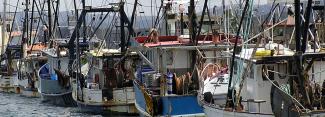
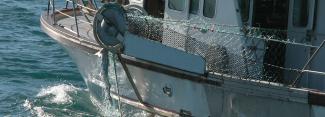
Target Species
| Species | Fishing Mortality* | Biomass** |
|---|---|---|
Macruronus novaezelandiae | G;Not subject to overfishing | G;Not overfished |
Neoplatycephalus richardsoni | G;Not subject to overfishing | G;Not overfished |
Seriolella punctata | G;Not subject to overfishing | G;Not overfished |
Mustelus antarcticus | G;Not subject to overfishing | G;Not overfished |
Genypterus blacodes | G;Not subject to overfishing | G;Not overfished |
Sillago flindersi | G;Not subject to overfishing | G;Not overfished |
* Fishing mortality status relates to the level of fishing pressure on a stock - specifically, whether fishing mortality in the year being assessed is likely to result in the stock becoming overfished, or prevent the stock from rebuilding from an overfished state. If fishing mortality exceeds either of these thresholds, a stock is considered to be subject to overfishing.
** Biomass status relates to how many fish there are - specifically, whether the biomass in the year being assessed is above the level at which the risk to the stock is considered to be unacceptable. The HSP defines this level as the limit reference point, below which the stock is considered to be overfished.
Catch allowance
| Species | 2025–26 total allowable catch (tonnes) | 2024–25 total allowable catch (tonnes) | 2023–24 total allowable catch (tonnes) |
|---|---|---|---|
| Blue grenadier | 17084 | 17084 | 17084 |
| Tiger flathead | 2333 | 2333 | 2333 |
| Silver warehou | 350 | 350 | 350 |
| Gummy shark | 1564 | 1558 | 1672 |
| Pink ling | 1541 | 1533 | 1565 |
| Eastern school whiting | 1202 | 914 | 914 |
Total fishery value (GVP)
$A 109.7 million (2020–21).
Fishing gear
Many different types of gear are used in this fishery.
AFMA regulates what fishing gear can be used to target certain fish species. Specific conditions are attached to each fishing permit that tell a fisher where they are allowed to fish and what kind of fishing gear may be used.
Click each gear type below to read more about that gear.
- Danish seine
- Bottom trawl
- Midwater trawl
- Pair trawl
- Purse seine
- Bottom longline
- Automatic longline
- Dropline
- Demersal gillnet
- Trap
Location
The Southern and Eastern Scalefish and Shark Fishery stretches south from Fraser Island in southern Queensland, around Tasmania, to Cape Leeuwin in southern Western Australia.
Major landing ports
- Eden
- Lakes Entrance
- Portland
- Devonport
- Hobart
- Port Welshpool
- Port Lincoln
- Thevenard
Markets supplied
- Fresh product – Australia
- Frozen product – Limited exports
Fishing season
12-month season, beginning on 1 May.
Management of catch
This fishery is managed under a quota system that limits the amount of fish that boats can take in the fishery. This quota limit is also known as a total allowable catch. Thirty-four different species/species groups are managed under the quota system in this fishery. Under this system, each fisher is limited to catching up to the amount of quota that they hold and the whole fishery is limited to the total allowable catch that is set each season. Setting quotas is one of the main methods AFMA uses to ensure these fish species remain sustainable.
The Southern and Eastern Scalefish and Shark Fishery Resource Assessment Groups and the South East Management Advisory Committee make recommendations to the AFMA Commission on what they think the total allowable catch for each species should be for each fishing season. Each year the AFMA Commission decides on the allowable catch using information provided by the fishery manager, industry members and scientists.
A number of sources are used to determine the amount of quota. For example, the Southern and Eastern Scalefish and Shark Fishery Harvest Strategy looks at the catch and effort data in the fishery, environmental factors, stock assessments for the main targeted species in the fishery and other available scientific information.
The total allowable catch for each target species in this fishery is based on the largest amount of catch of a species that can be taken out of the ocean each year over an indefinite period (also known as maximum sustainable yield).
Licence to fish
Fishers need to be allocated statutory fishing rights to fish in this fishery.
Statutory fishing rights allow fishers to fish in the fishery and catch the fish species that are under a quota. The amount of quota an operator is allocated depends on the amount of rights they hold. The amount of quota changes every year.
Statutory fishing rights are transferable between fishers, they may also be known as individually transferable quota.
In the fishery there are currently:
- 36 trawl statutory fishing rights
- 37 scalefish hook statutory fishing rights
- 61 shark gillnet statutory fishing rights
- 13 shark hook statutory fishing rights.
Collecting data
Data about the catch and effort of the fishery is collected from the logbooks fishers have to fill out for every fishing operation. Logbooks record:
- the species and amount caught
- catch that is discarded
- the catch/release of any protected species and their life status
- set and haul times of each operation
- the location of each operation
- the type and amount of gear used.
Harvest strategy
A harvest strategy is used to help determine what the quota should be for the target species of the fishery. Fishing, environmental and economic information is included in the harvest strategy, which helps to monitor and maintain the sustainability of the targeted species.
All harvest strategies are developed in line with the Commonwealth Fisheries Harvest Strategy Policy and Guidelines.
View the Southern and Eastern Scalefish and Shark Fishery Harvest Strategy.
Fishery closures
A number of fishery closures are used in the fishery to manage both commercial species and bycatch species by protecting spawning habitat or to exclude a type of fishing gear from an area where bycatch issues are known to occur.
Indicative maps of these closures can be found in the Southern and Eastern Scalefish and Shark Fishery Management Arrangements Booklet.
Species sustainability
AFMA uses the information collected from logbooks and the Integrated Scientific Monitoring Program to conduct stock assessments. In this fishery, a tiered approach is used to assess different species based on the amount of information available. The outcome of these stock assessments is a recommended biological catch.
The recommended biological catch is the best scientific advice on what the total fishing mortality (landings from all sectors plus discards) should be for each species/stock. Harvest control rules are then applied to the recommended biological catch to calculate the weight of fish which can be sustainably caught. This is called the total allowable catch.
In this fishery, resource assessment groups annually review catches and the biological information collected. Where possible, stock assessments are completed to determine the status of the stock.
Species rebuilding strategies
Under the Commonwealth Fisheries Harvest Strategy Policy 2007, rebuilding strategies are required to be developed for all species which are below their biomass limit reference point. For most species, the limit reference point of 20 per cent of the unfished breeding stock is used. There are four species currently managed under rebuilding strategies in this fishery:
- Eastern gemfish
- Orange roughy
- School shark
- Blue warehou
These strategies focus on the management actions needed to support stock recovery within a biologically reasonable timeframe and maximise its chances of long-term survival.
To achieve this, the strategies:
- do not allow targeted fishing for rebuilding stocks
- ensure that incidental catch of the species is kept to a minimum
- contain measures to improve knowledge of stock status, including data collection and monitoring.
AFMA also has a management strategy in place for two species of upper-slope dogfish: Harrisson’s dogfish and southern dogfish. While not strictly a rebuilding strategy developed under the Commonwealth Harvest Strategy Policy 2007, it uses the same management arrangements mentioned above to achieve long-term recovery for these species.
Jackass morwong and John dory were also assessed as overfished in 2021. Since then, AFMA has implemented management arrangements to reduce the catch of both species, including significantly reduced TACs, and from 1 May 2023 will implement a network of closures along the east coast aimed at constraining catches of at-risk species. Rebuilding strategies for these species will be developed during 2023
Species risk assessments
AFMA regularly monitor the effects fishing activities have on marine species, habitats and communities through ecological risk assessments. The assessment results help to prioritise the management, research, data collection and monitoring needs for the fishery.
After the risk assessment is complete, an ecological risk management strategy is developed to address how AFMA will manage risks to marine species, habitats and communities identified in the assessment as impacted by commercial fishing operations.
View the risk assessments and management strategies for the Southern and Eastern Scalefish and Shark Fishery.
Bycatch and discarding workplans
A bycatch and discarding workplan outlines ways to minimise the bycatch of species that are caught as bycatch in the fishery. These species can include; threatened, endangered and protected species and other non-targeted fish species.
View the bycatch and discarding workplan for the Southern and Eastern Scalefish and Shark Fishery.
Fishery closures for bycatch
A number of fishery closures are used in this fishery to manage commercial species and bycatch species by protecting breeding habitats or excluding specific types of fishing gear from an area where bycatch issues are known to occur.
Currently there are fishery area closures to prevent the bycatch of Australian sea lions, dolphins and upper-slope dogfish.
Protected species
There are a number of threatened, endangered and protected species found within the area of this fishery.
Fishers must report any interaction with a protected species while fishing. AFMA also uses electronic monitoring systems to help monitor protected species interactions on some boats.
While the impact of fishing activities on most of these species is very small, there are a number of management arrangements for protected species in this fishery.
In consultation with the Department of Climate Change, Energy, the Environment and Water and other stakeholders, AFMA has developed management arrangements for:
- Australian sea lions
- dolphins
- seabirds
- upper-slope dogfish
- fur seals.
View AFMA’s protected species management strategies.
Export approvals
To export from an Australian commercial fishery the fishery must be approved as a wildlife trade operation by the Department of Climate Change, Energy, the Environment and Water under the Environment Protection and Biodiversity Conservation Act 1999 (EPBC Act).
The Southern and Eastern Scalefish and Shark Fishery maintains a wildlife trade operation accreditation which recognises that the fishery is being managed in an ecologically sustainable manner allowing the export of product from the fishery.
View the most recent accreditation conditions and recommendations for the Southern and Eastern Scalefish and Shark Fishery.
Marine reserves
Commonwealth marine reserves are areas established under Australian environment law to help conserve the spectacular marine life in our oceans. They allow ecologically sustainable use of our marine resources and provide special places for people to enjoy and appreciate the fantastic diversity of our marine habitats.
Marine reserves are sometimes known as marine protected areas or marine parks and are managed by the Department of Climate Change, Energy, the Environment and Water.
More information about marine reserves can be found on the Department of Climate Change, Energy, the Environment and Water website.
Fishing in the fishery
Fishing operators wanting to fish in the Southern and Eastern Scalefish and Shark Fishery must hold:
- a boat statutory fishing right
- quota statutory fishing rights for quota species in the fishery.
Download a copy of the Southern and Eastern Scalefish and Shark Fishery Management Arrangements Booklet for a description of all fishing requirements in the fishery.
Fishery legislation
The management of the Southern and Eastern Scalefish and Shark Fishery is governed by the following legislation:
- Fisheries Management Act 1991
- Fisheries Administration Act 1991
- Fisheries Management Regulations 2019
- Southern and Eastern Scalefish and Shark Fishery Management Plan 2003
SESSF Closures and Directions
A summary of SESSF closures is available on this page: Maps of directions, closures and fishing areas
(including electronic map files: GPX, KMZ and SHP)
Management plan
The Southern and Eastern Scalefish and Shark Fishery Management Plan 2003 came into effect on 1 October 2003.
Total allowable commercial catch determination
The Southern and Eastern Scalefish and Shark Fishery Total Allowable Commercial Catch Determinations for quota species, non-quota species and overcatch and undercatch sets the total allowable commercial catch limits for each fishing season. These limits are recommended by AFMA in consultation with our committees and decided by the AFMA Commission.
We recognise that fisheries management involves a broad range of stakeholders.
Here are just a few ways we are working with our stakeholders, who include industry, scientists, environmental groups and the community for an informed approach to fisheries management.
Fishing industry
Each fishing season, AFMA officers visit the major fishing ports of the fishery. These visits allow AFMA and fishers to meet directly to discuss any concerns. Discussions about the current trends in fishing and catches during the season are also valuable information gained on these visits. All this information is useful for the continuing management of the fishery.
Recreational fishers
Some of the fish species caught in the Southern and Eastern Scalefish and Shark Fishery are also caught by recreational fishers. Although recreational fishing is managed by the relevant state authority AFMA engages regularly with recreational fishers to discuss issues of mutual concern.
Government departments
AFMA works closely with other government departments, such as the Department of Agriculture, Fisheries and Forestry and the Department of Climate Change, Energy, the Environment and Water. They help in providing advice and guidance on both domestic and international fisheries issues.
State governments
The Australian state governments manage fishing from the Australian coast out to 3 nm. Occasionally there is some overlap in fishing operations of state and commonwealth jurisdictions and AFMA regularly communicates with the state fisheries agencies to manage any problems.
Environmental non-government organisations
A representative of conservation/environmental non-government organisations is a member of the South East Management Advisory Committee and provides input and advice to this committee.
Management advisory committees
The South East Management Advisory Committee and the Great Australian Bight Management Advisory Committee are the main groups that discuss and provide advice on the management of the Southern and Eastern Scalefish and Shark Fishery.
See the South East Management Advisory Committee and the Great Australian Bight Management Advisory Committee webpages for a summary of the latest discussions and outcomes from the committees.
Southern and Eastern Scalefish and Shark Fishery Resource Assessment Group
The Southern and Eastern Scalefish and Shark Fishery Resource Assessment Group is the overarching assessment group providing research and scientific advice for the fishery. Advice and recommendations are provided to and from three other resource assessment groups responsible for certain species stock assessments. They are listed below.
Southern and Eastern Scalefish and Shark Fishery Resource Assessment Group and species assessed as part of the stock assessment that relate to each are as follows:
| South East Resource Assessment Group (SERAG) | |
|---|---|
| Shark Resource Assessment Group | Great Australian Bight Resource Assessment Group |
|
|
|
|
Marine Mammal Working Group
The Marine Mammal Working Group is an advisory committee made up of fishers, scientists, environmental representatives, marine mammal experts and government representatives set up to provide AFMA with specialist advice to assist fisheries managers in the development and implementation of management measures to minimise fishery interactions with marine mammals.
A sub-committee of the Marine Mammal Working Group, the Dolphin Mitigation Sub-Committee, was established in 2013 to provide AFMA with specialist advice on dolphin mitigation and assist in the development and implementation of AFMA’s dolphin strategy.
Management publications
- Multi-species harvest strategy – workshop report
- Evaluation of new harvest strategies for SESSF species
- SESSF TAC setting process guidelines and time frames
- Management Arrangements Booklet – Southern and Eastern Scalefish and Shark Fishery
- GAB Boat operating procedures manual 2024–25
- Southern and Eastern Scalefish and Shark Fishery Harvest Strategy Transitional Arrangements
- Harvest Strategy – Southern and Eastern Scalefish and Shark Fishery 2024
- Southern and Eastern Scalefish and Shark Fishery Management Plan
- Boat Operating Procedures Manual – Great Australian Bight Trawl Sector (PDF, 8 MB)
- Boat Operating Procedures Manual – list of latest cards – Great Australian Bight Trawl Sector (PDF, 25 KB)
- Bycatch and Discard Workplan – Southern and Eastern Scalefish and Shark Fishery
Environment publications
- Ecological risk assessment reports (ERAs)
- Implications of current spatial management measures for AFMA ERAs for habitats (PDF, 2 MB)
- An evaluation of ichthyoplankton monitoring at IMOS National Reference Stations 2016 (PDF, 5 MB)
- Guide to Developing New Seabird Mitigation Devices in Trawl Fisheries (PDF, 67 KB)
Protected species management
- Orange Roughy Research Plan for the Great Australian Bight Trawl Fishery 2025
- Western Orange Roughy Research Plan
- Australian Sea Lion Management Strategy
- Assessment of the use of shortened codends to mitigate seal interactions in the SESSF 2014 (PDF, 1 MB)
- Dolphin Strategy
- Upper-Slope Dogfish Management Strategy (PDF, 2 MB)
Rebuilding strategies
The rebuilding strategies can be found on the commercial fish species rebuilding strategies page.
The five-year review reports (published July 2020) are also available there.
Data and ISMP publications
- SESSF Data Plan (Revised August 2024) (PDF, 1.3 MB)
- SESSF Data Plan 2021–2023 (PDF, 1.5 MB)
- (Bergh et al, 2009) A revised sampling regime for the SESSF (PDF, 5.3 MB)
- ISMP 2020 annual report (PDF, 787 KB)
- ISMP 2019 annual report (PDF, 1.2 MB)
- SESSF data summary up to 2020 (PDF, 67.2 MB)
- SESSF data summary up to 2019 (PDF, 6.5 MB)
- SESSF data summary up to 2018 (PDF, 6 MB)
- SESSF 2021 ISMP Discards report data up to 2020 (PDF, 3.26 MB)
- SESSF 2020 ISMP Discards report data up to 2019 (PDF, 3.3 MB)
- SESSF 2019 ISMP Discards report data up to 2018 (PDF, 3.5 MB)
Species summaries
- 2025 SESSF species summaries (PDF, 3.2 MB)
- 2024 SESSF species summaries (PDF, 3.58 MB)
- 2023 SESSF species summaries (PDF, 4.33 MB)
- 2021 SESSF species summaries (180 pages – 4.5 MB PDF)
- SESSF species summaries from 2018 stock assessments (PDF, 7 MB)
- SESSF species summaries from 2017 stock assessments (PDF, 2 MB)
- SESSF species summaries from 2016 stock assessments (Word)
- SESSF species summaries from 2015 stock assessments (PDF, 3 MB)
- SESSF species summaries from 2013 stock assessments 2014 (PDF, 3 MB)
Stock assessments
- Tier 4 Assessments for SESSF Species
- Gummy Shark Stock Assessment 2023
- Gummy Shark Assessment 2020
- School shark Close Kin Mark Recapture assessment review report (PDF)
- School shark Close Kin Mark Recapture assessment review report addendum (PDF)
- Pink Ling Tier 1 stock assessment 2018 (Cordue) (PDF, 3 MB)
- Stock Assessments for SESSF 2020–21 – Part 1 (PDF, 48 MB)
- Stock Assessments for SESSF 2020–21 – Part 2 (PDF, 30 MB)
- Stock assessments for SESSF: 2019 – Part 1 (PDF, 28 MB)
- Stock assessments for SESSF: 2019 – Part 2 (PDF, 53 MB)
- Stock assessments for SESSF: 2018 – Part 1 (PDF, 37 MB)
- Stock assessments for SESSF: 2018 – Part 2 (PDF, 51 MB)
- Stock assessments for the Southern and Eastern Scalefish and Shark Fishery: 2016–2017 Part 1 (PDF, 21 MB)
- Stock assessments for the Southern and Eastern Scalefish and Shark Fishery: 2016–2017 Part 2 (PDF)
- Stock Assessment for the Southern and Eastern Scalefish and Shark Fishery: 2015 – Part 1 (PDF 2 MB)
- Stock Assessment for the Southern and Eastern Scalefish and Shark Fishery: 2015 – Part 2 (PDF, 15 MB)
- Stock Assessment for the Southern and Eastern Scalefish and Shark Fishery: 2014 Part 1 (PDF, 8 MB)
- Stock Assessment for the Southern and Eastern Scalefish and Shark Fishery: 2014 Part 2 (PDF, 16 MB)
- Stock Assessment for the Southern and Eastern Scalefish and Shark Fishery: 2013 Part 1 (PDF)
- Stock Assessment for the Southern and Eastern Scalefish and Shark Fishery: 2013 Part 2 (PDF)
- Stock Assessment for the Southern and Eastern Scalefish and Shark Fishery: 2012 Part 1 (PDF)
- Stock Assessment for the Southern and Eastern Scalefish and Shark Fishery: 2012 Part 2 (PDF)
- Stock Assessment for the Southern and Eastern Scalefish and Shark Fishery: 2011 Part 1 (PDF)
- Stock Assessment for the Southern and Eastern Scalefish and Shark Fishery: 2011 Part 2 (PDF)
Research plans and statements
- SESSF Five Year Strategic Research Plan 2021–2025
- SESSF Annual Research Statement 2022–2023
- GABT Annual Research Statement 2022–2023
Research publications
- Setting economic target reference points for multiple species in mixed fisheries – FRDC June 2015 (PDF 4 MB)
- Electronic Monitoring Trial report in the CTS – published June 2021 (PDF, 1.7 MB)
- ABARES logbook and EM data congruence analysis 2022 (PDF, 12 MB)
- Implementation of a survey program to monitor recovery of Conservation Dependent Southern Dogfish and Harrisson’s Dogfish
FIS reports
- Continuation of a Fishery Independent Survey for the SESSF 2016 (PDF, 3 MB)
- Continuation of a Fishery Independent Survey for the SESSF 2014 (PDF, 3 MB)
Tools
The Southern and Eastern Scalefish and Shark Fishery is a multi-sector, multi-species fishery that covers almost half of the Australian Fishing Zone. The fishery operates in both Commonwealth and state waters under different Offshore Constitutional Settlement arrangements with state governments.
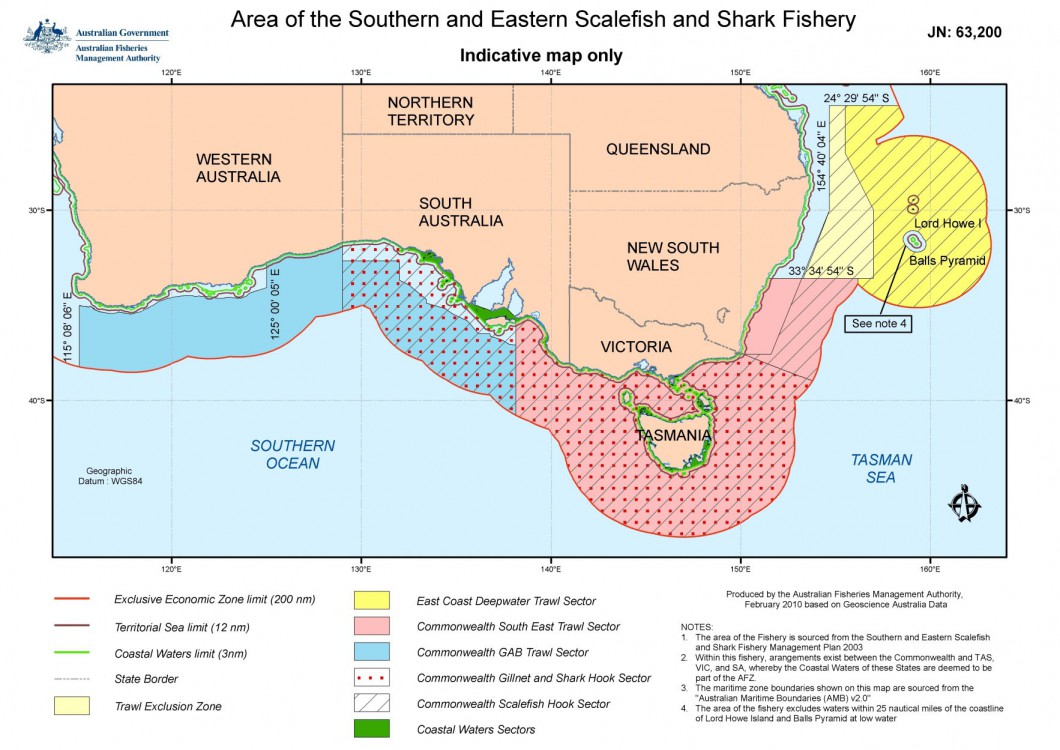
The fishery is comprised of the following major sectors:
Commonwealth South East Trawl Sector
This sector covers the area of the AFZ extending southward from Barrenjoey Point (north of Sydney) around the New South Wales, Victorian and Tasmanian coastlines to Cape Jervis in South Australia.
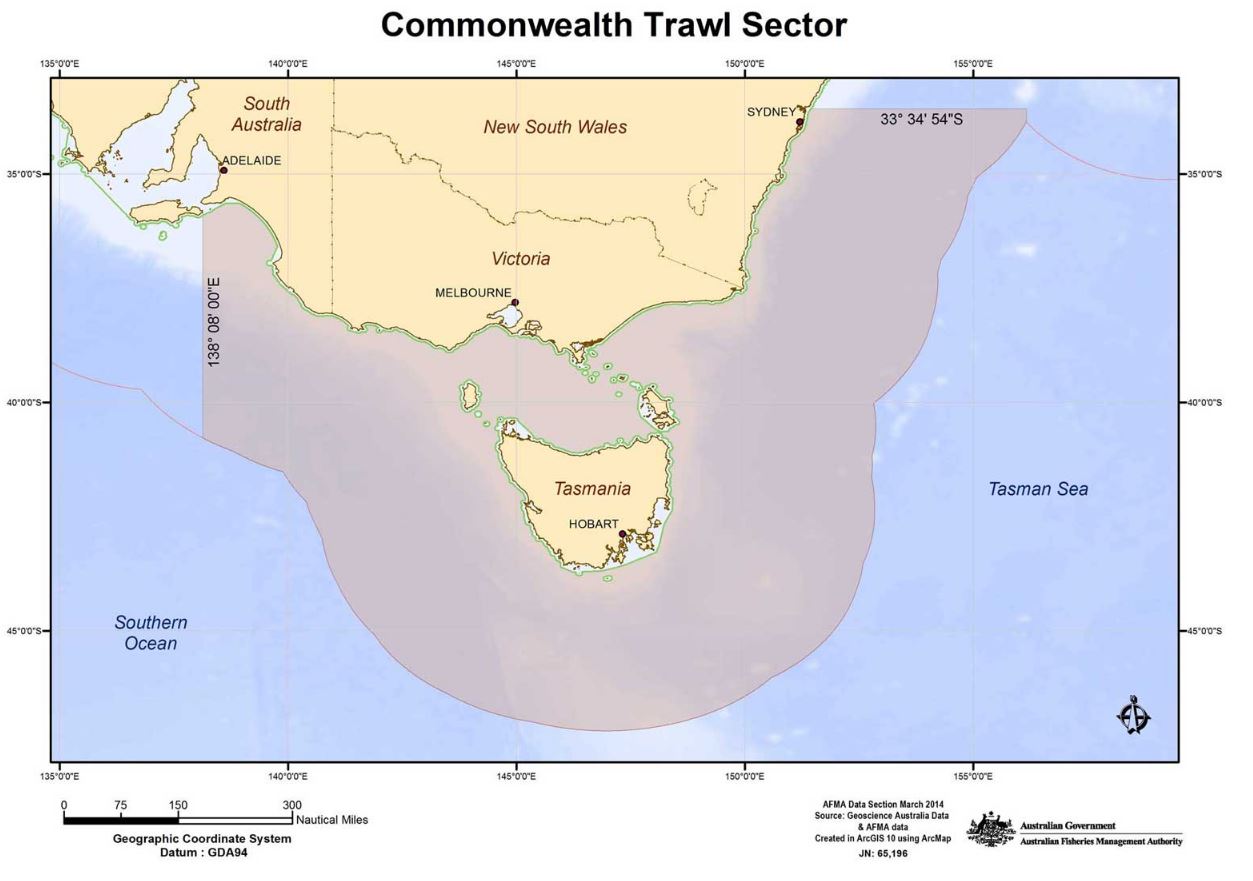
East Coast Deepwater Trawl Sector
This sector extends in a radius around Lord Howe Island off New South Wales. All fishing methods are prohibited within 25 nm of Lord Howe Island and Ball’s Pyramid, and the sector is bounded to the west by a trawl exclusion zone.
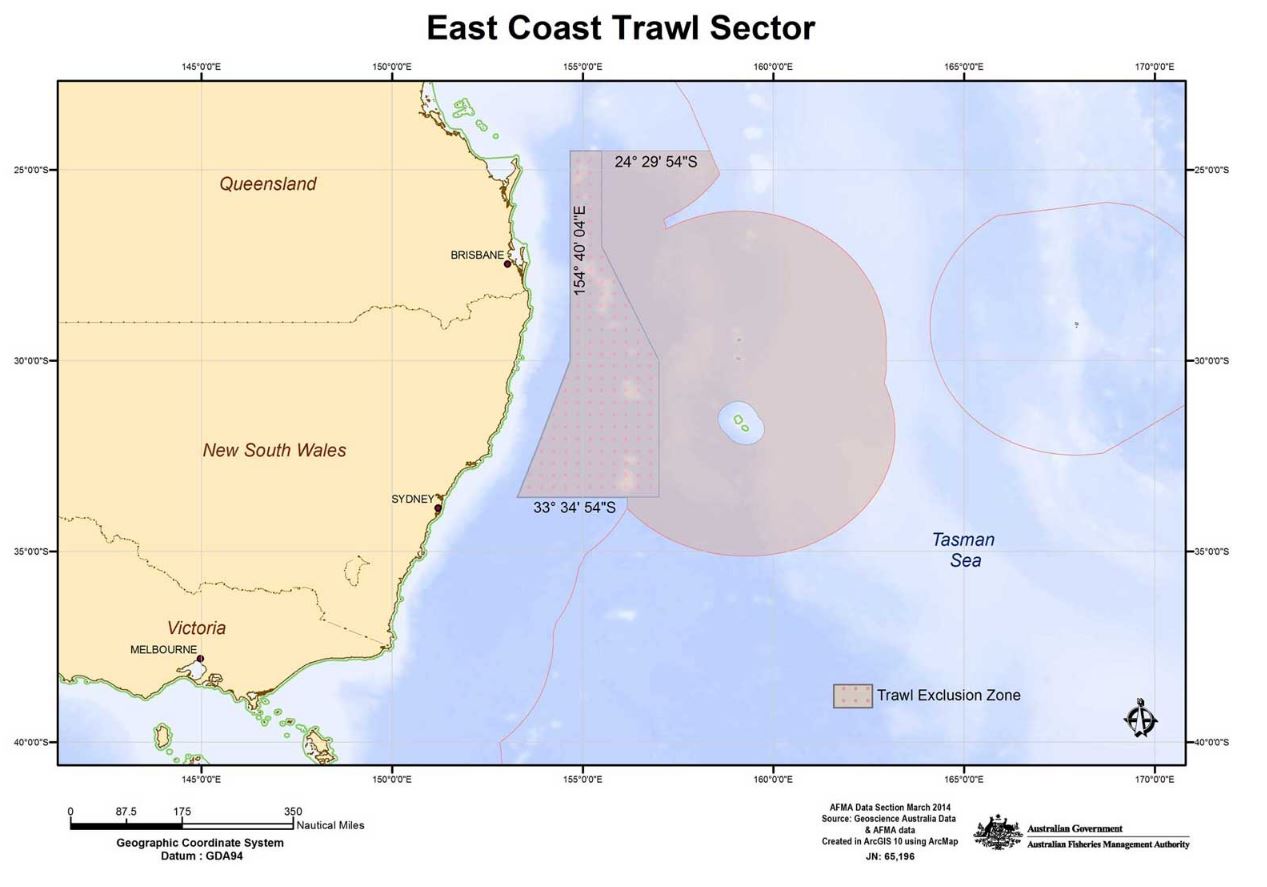
Scalefish Hook Sector
This sector includes all waters off South Australia, Victoria and Tasmania from 3 nm to the extent of the Australian Fishing Zone. It also includes waters off southern Queensland (south of Sandy Cape) and New South Wales from approximately the 4000 m depth contour (60–80 nm from the coast) to the extent of the AFZ. Waters inside this line off the New South Wales and Queensland coasts, and inside 3 nm around South Australia, Victoria and Tasmania, are managed by the state governments.
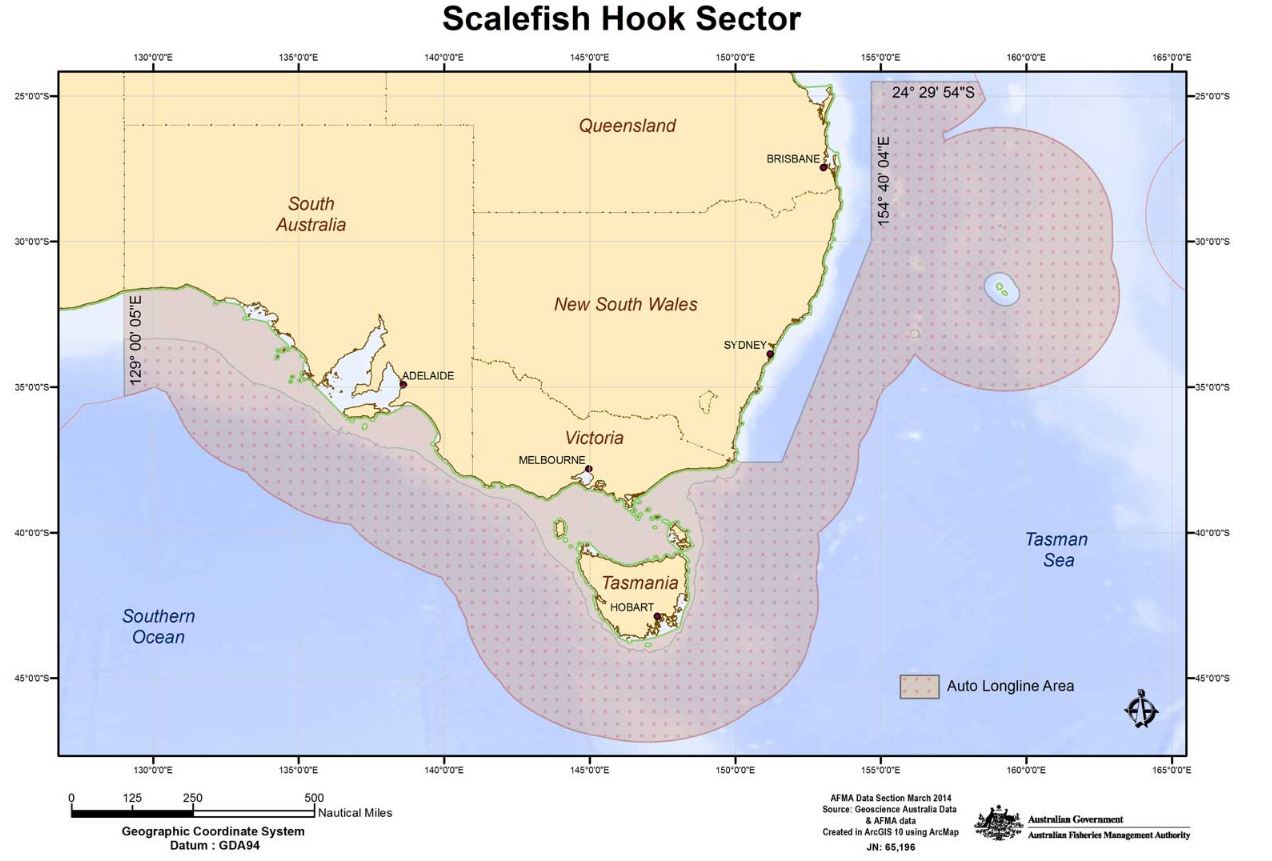
Shark Hook and Shark Gillnet Sector
This sector include waters from the New South Wales/Victorian border westward to the South Australian/Western Australian border, including the waters around Tasmania, from the low water mark to the extent of the Australian Fishing Zone.
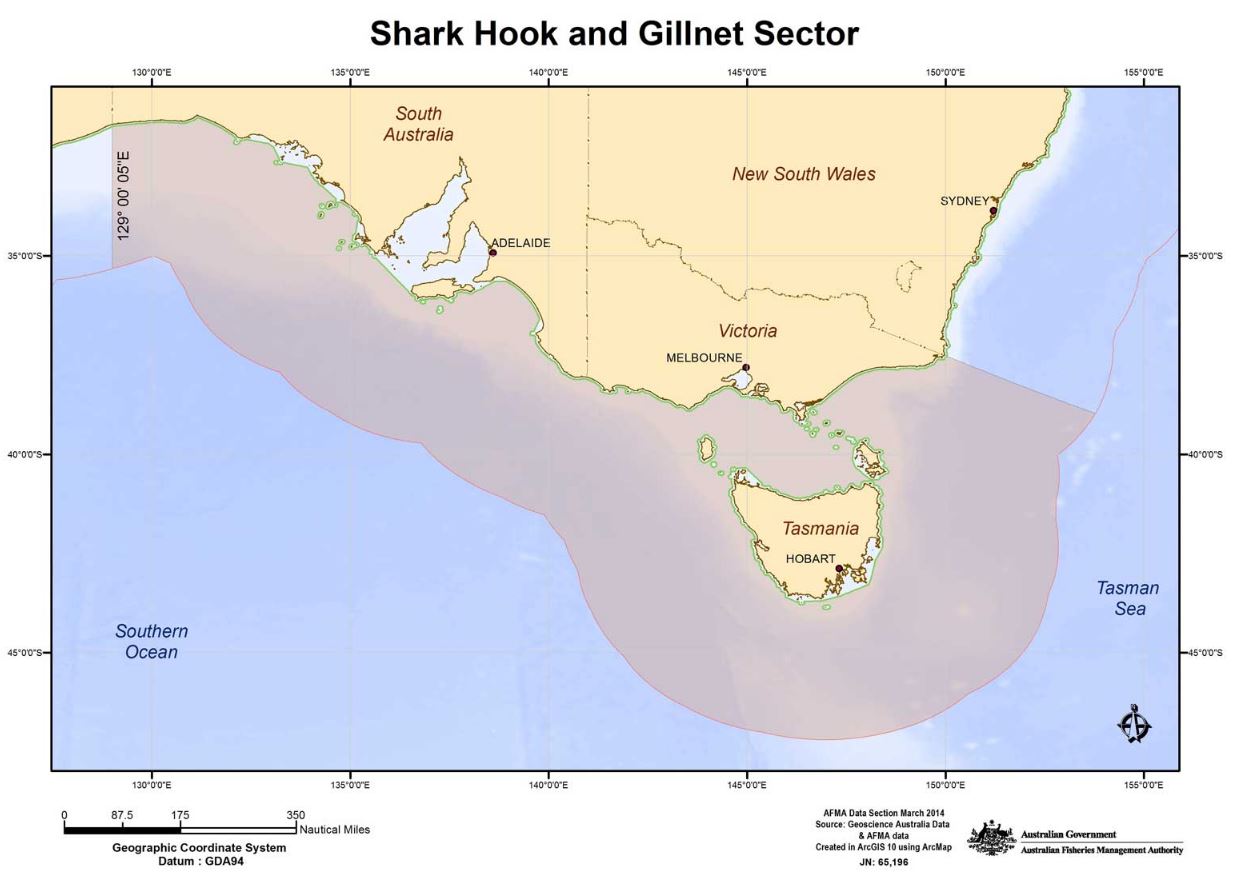
Trap Sector
Each trap operator has a different area in which they are authorised to fish. Refer to concession conditions for more information.
Great Australian Bight Trawl Sector
This sector extends from Cape Jervis in South Australia westward to Cape Leeuwin in southern Western Australia.
Refer to the Boat Operating Procedures Manual for the Great Australian Bight Trawl Fishery for management arrangements in this sector.
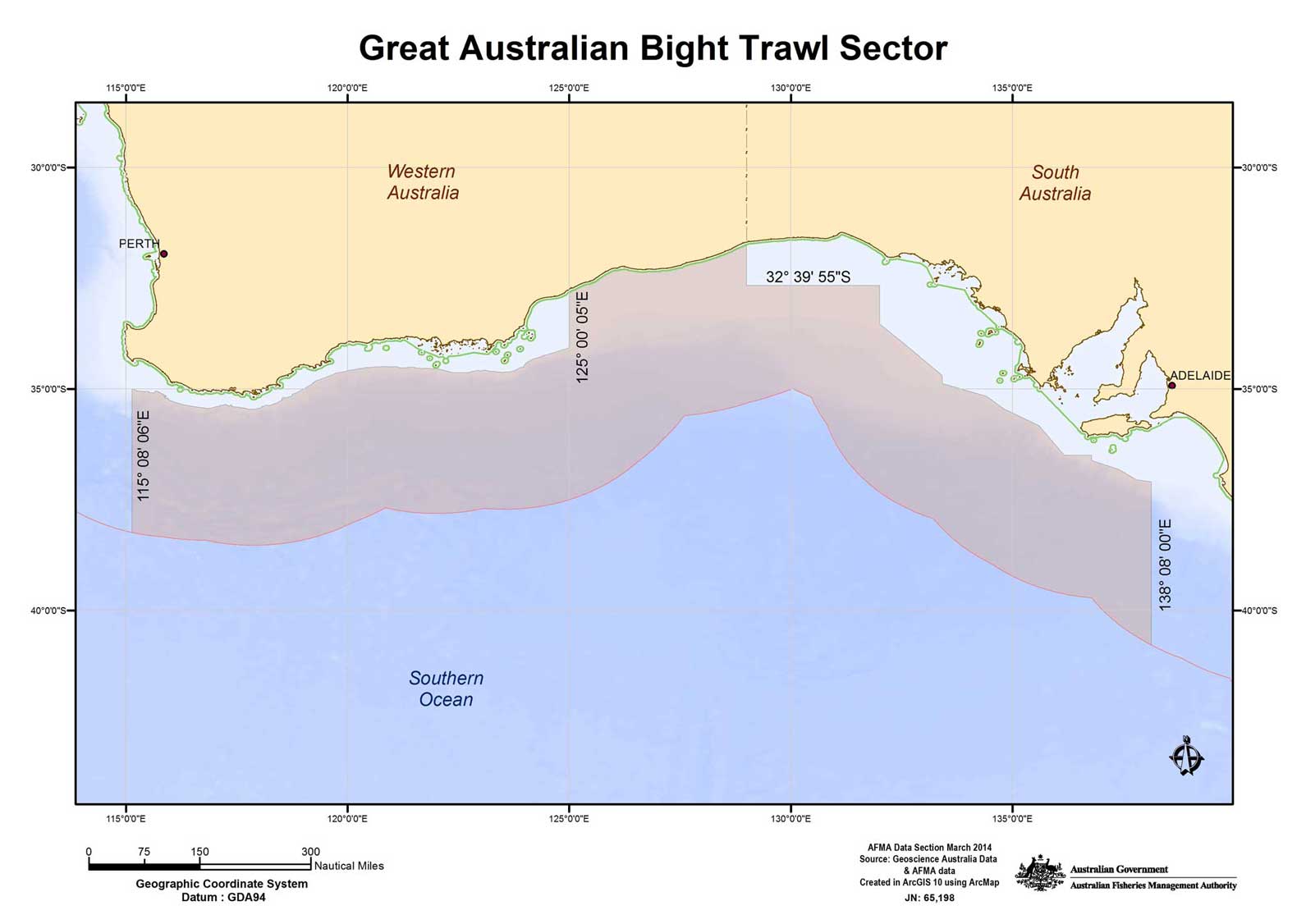
Fishery closure maps
Commonwealth Trawl closures
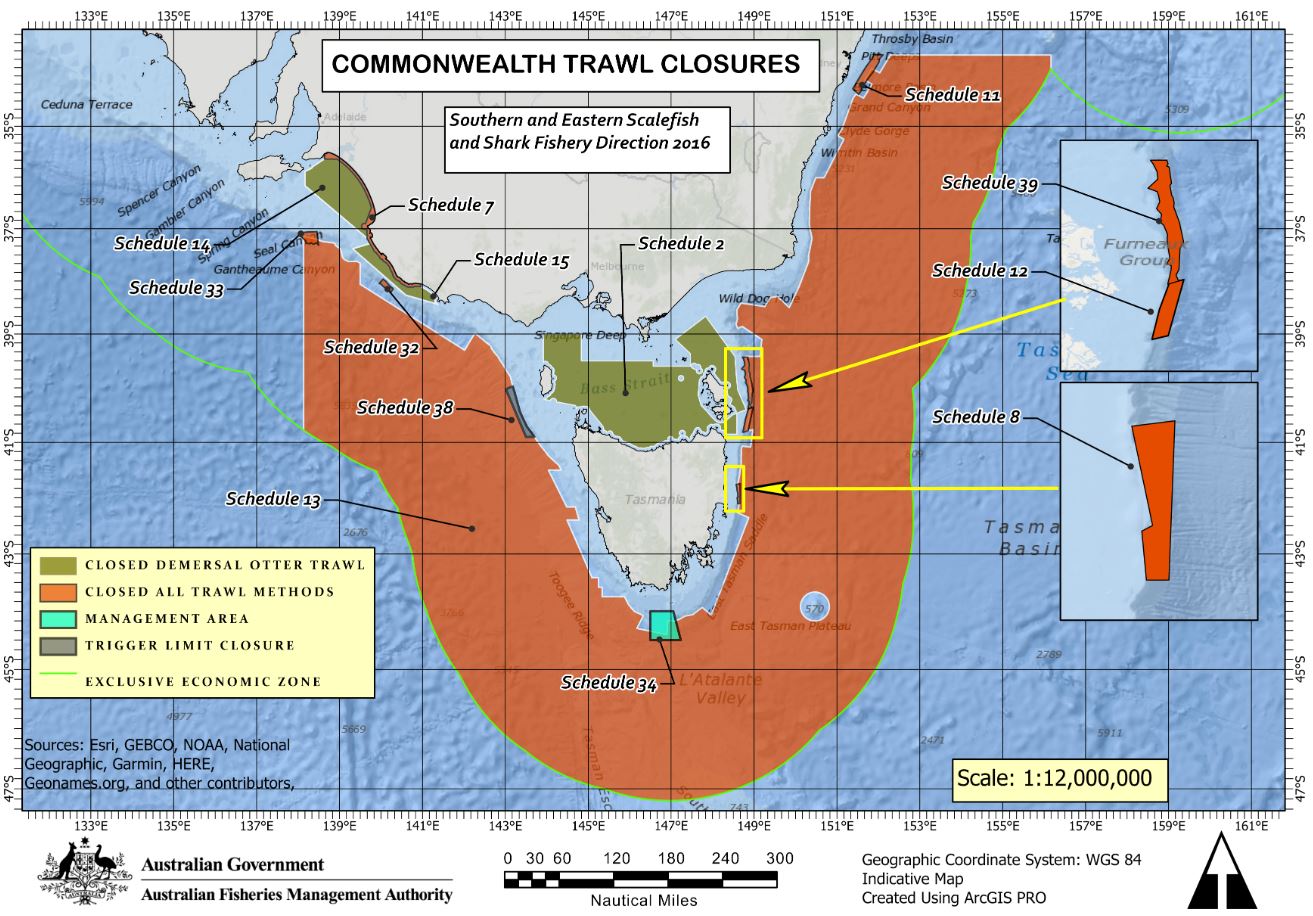
Scalefish and Shark Hook closures
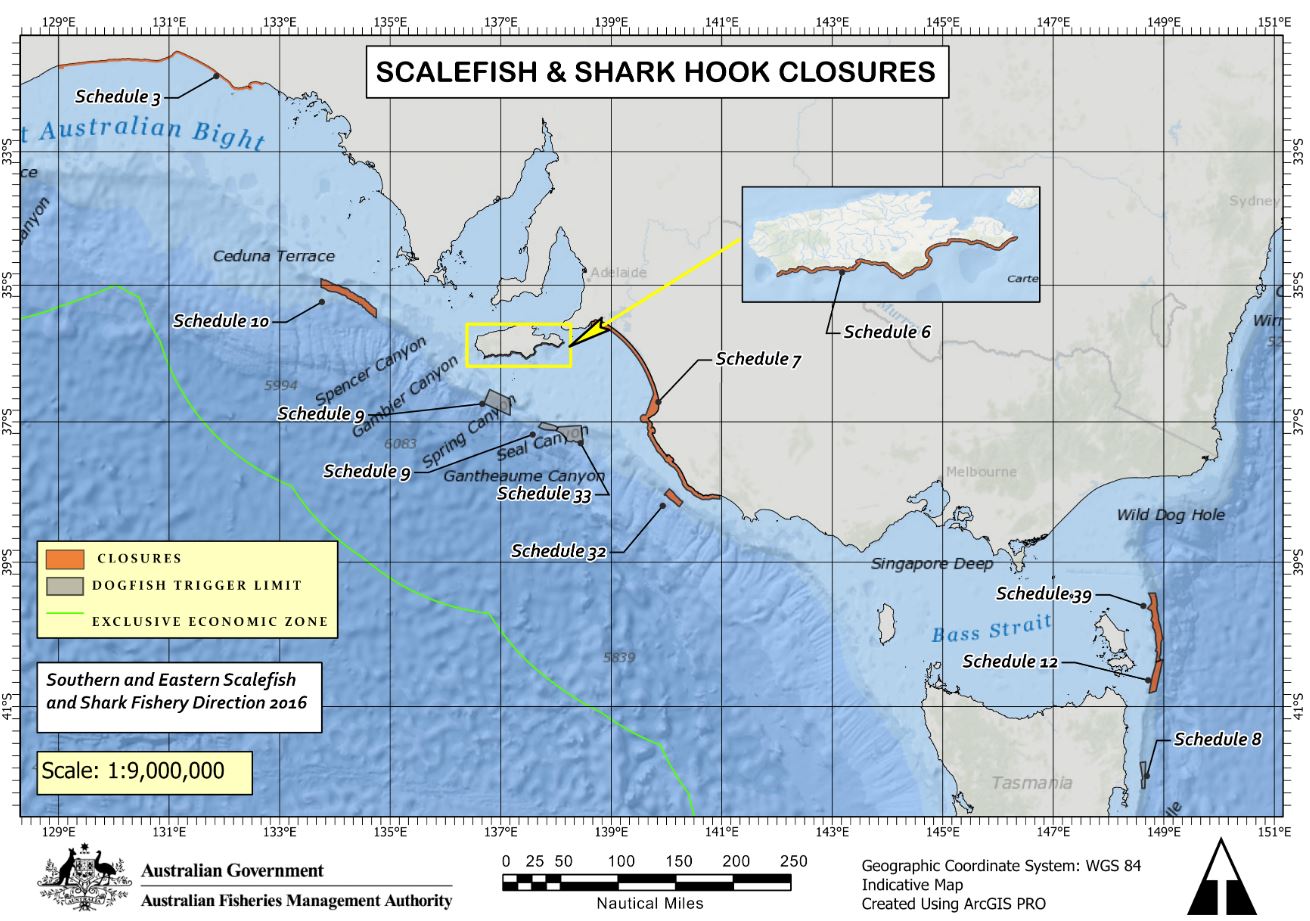
Gillnet closures
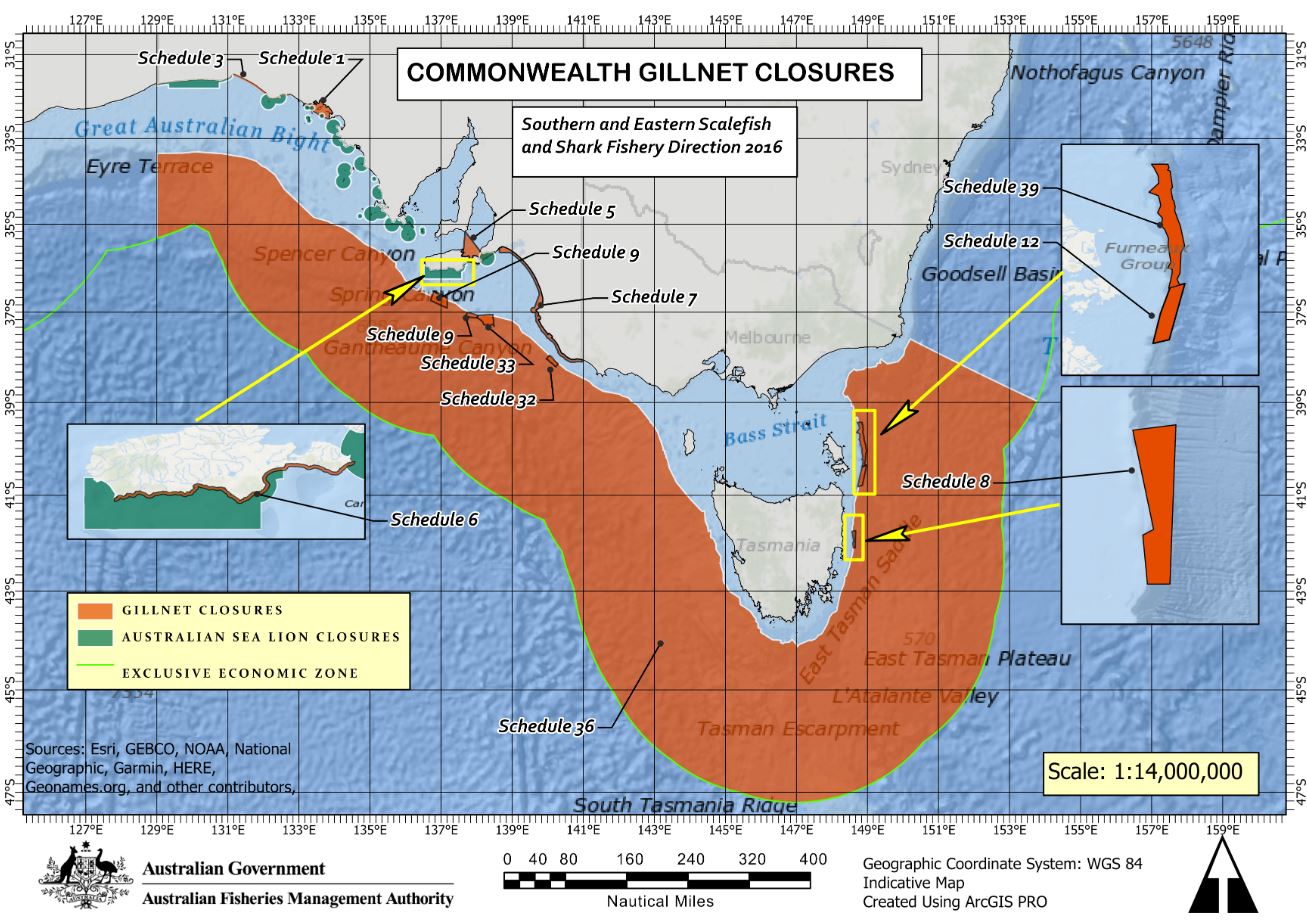
Australian sea lion closures
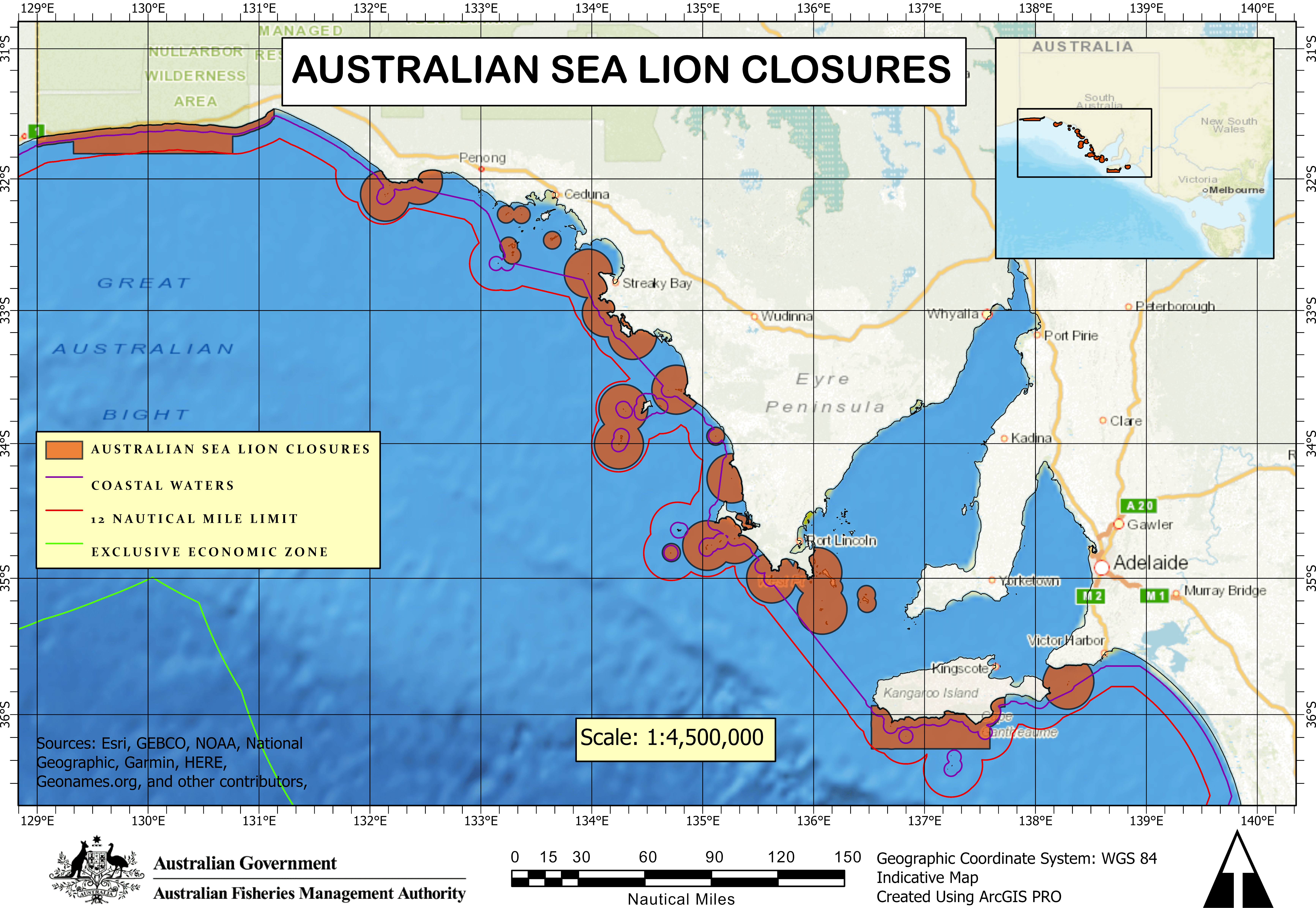
Auto longline closures
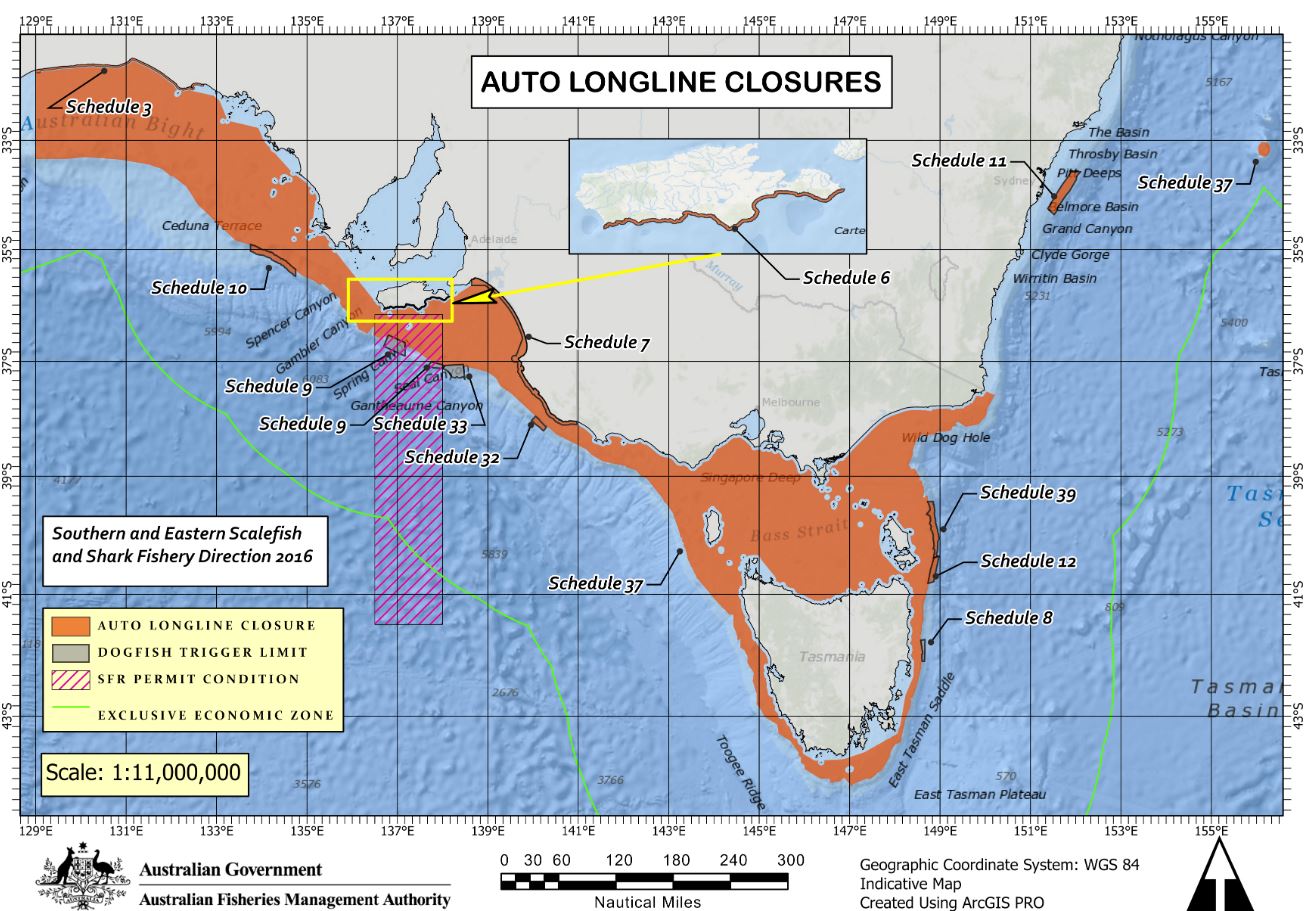
Great Australian Bight closures
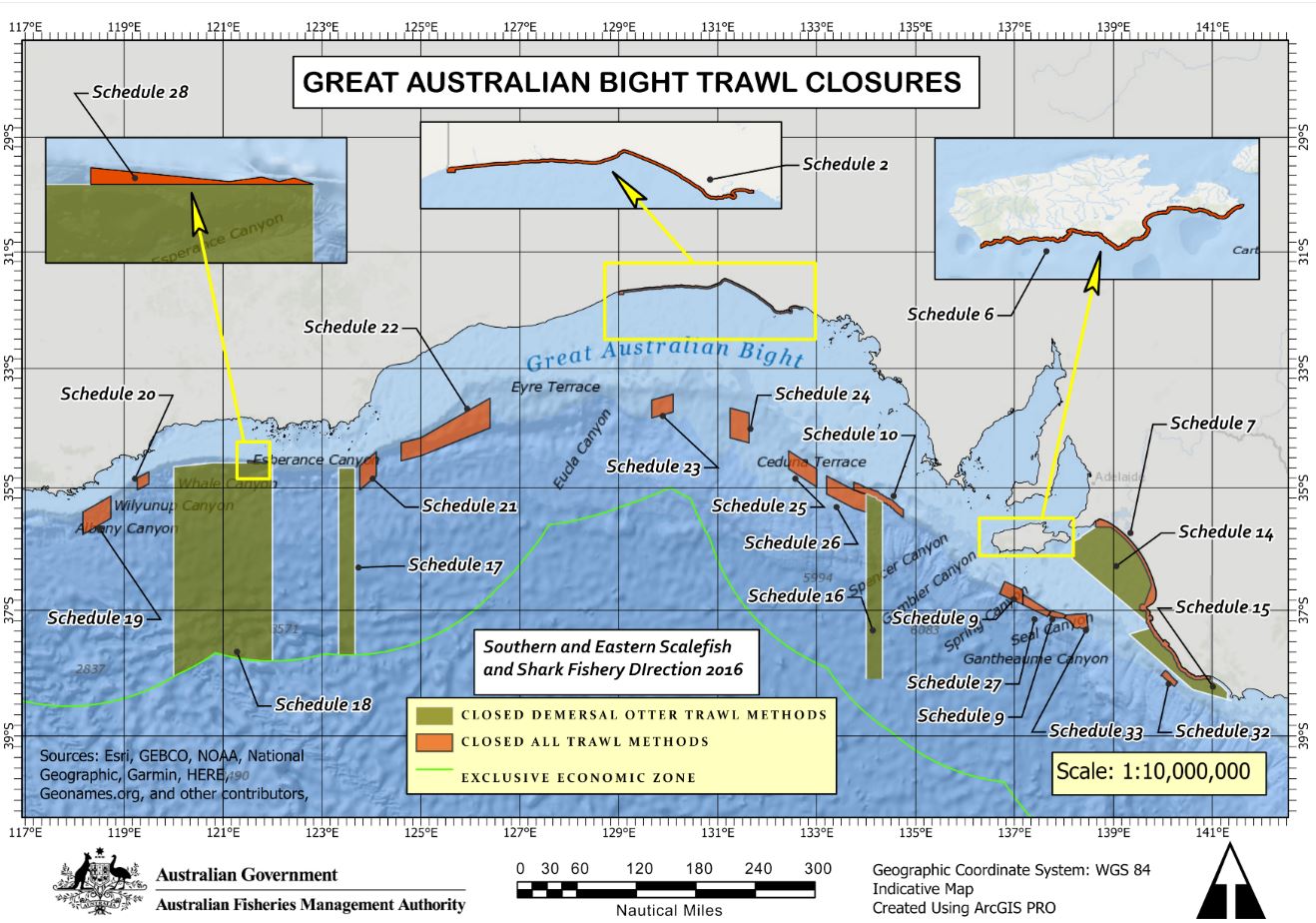
East Coast Southern and Eastern Scalefish and Shark Fishery closures
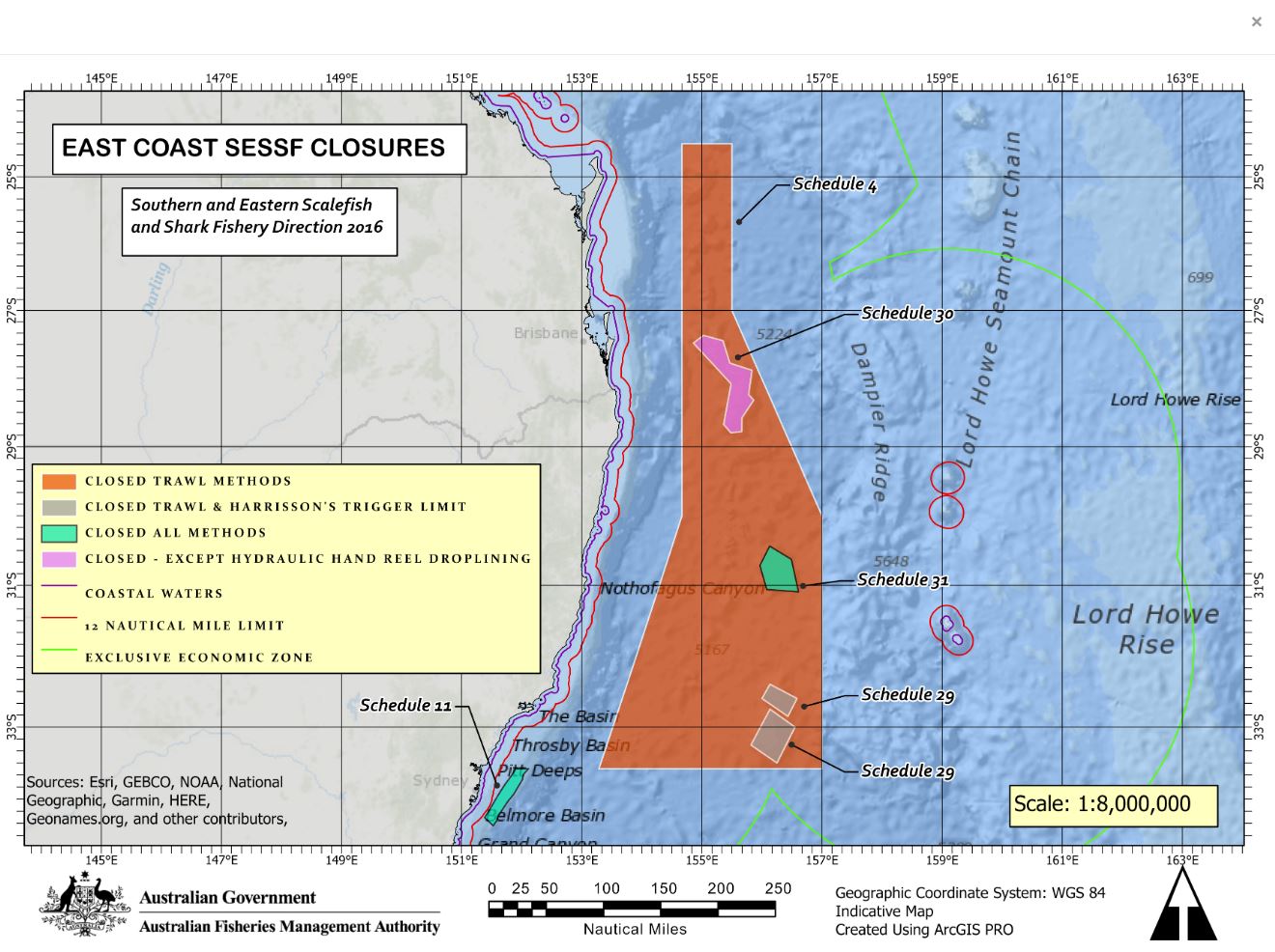
AFMA uses many methods to monitor the compliance of fishing activities and collect data on fish stocks. These include:
Onboard observers
One of the main monitoring methods used by AFMA is onboard scientific observers. Observers are people employed by AFMA to go out on boats and independently record catch, effort and biological information of each fishing trip.
They take samples from fish, such as the otoliths or ear bones, and these are used later to determine the age of the fish caught.
Observers also record the length, weight and sex of a sample of the fish caught during a trip and report on the other wildlife that may be seen, the weather conditions, the composition of commercial catch fate of species that are caught as bycatch.
Boats in the Southern and Eastern Scalefish and Shark Fishery must carry an AFMA observer when requested by AFMA.
Read more about the Observer program.
Satellite tracking
A satellite monitoring system called a Vessel Monitoring System, or VMS for short, is fitted on all concession holders boats. This system helps AFMA to monitor vessel position, course and speed. The system regularly transmits the information to a database at AFMA.
Read more about our satellite vessel tracking and monitoring program.
Cameras on fishing boats – electronic monitoring
AFMA has electronic monitoring systems on some fishing boats. These systems have sensors linked to surveillance cameras that record fishing activity. These recordings can then be collected and monitored by AFMA. Electronic monitoring gives fishers a cost effective way to support monitoring and data collection.
Read more about electronic monitoring of fishing boats.